人教版高中英语必修3课件 Unit 4 Astronomy reading (30张PPT)
文档属性
| 名称 | 人教版高中英语必修3课件 Unit 4 Astronomy reading (30张PPT) | 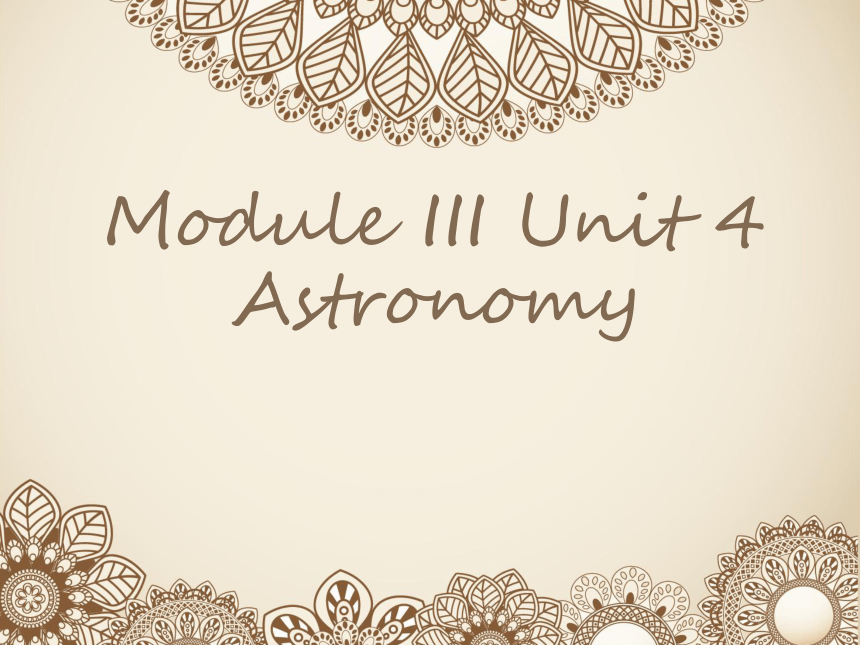 | |
| 格式 | zip | ||
| 文件大小 | 1.1MB | ||
| 资源类型 | 教案 | ||
| 版本资源 | 人教版(新课程标准) | ||
| 科目 | 英语 | ||
| 更新时间 | 2020-03-20 09:06:25 | ||
图片预览

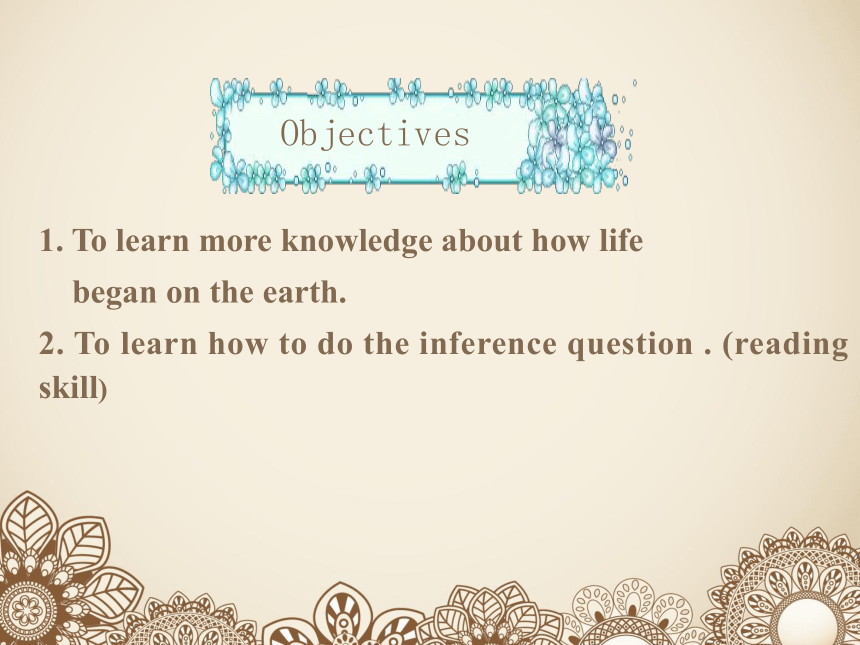

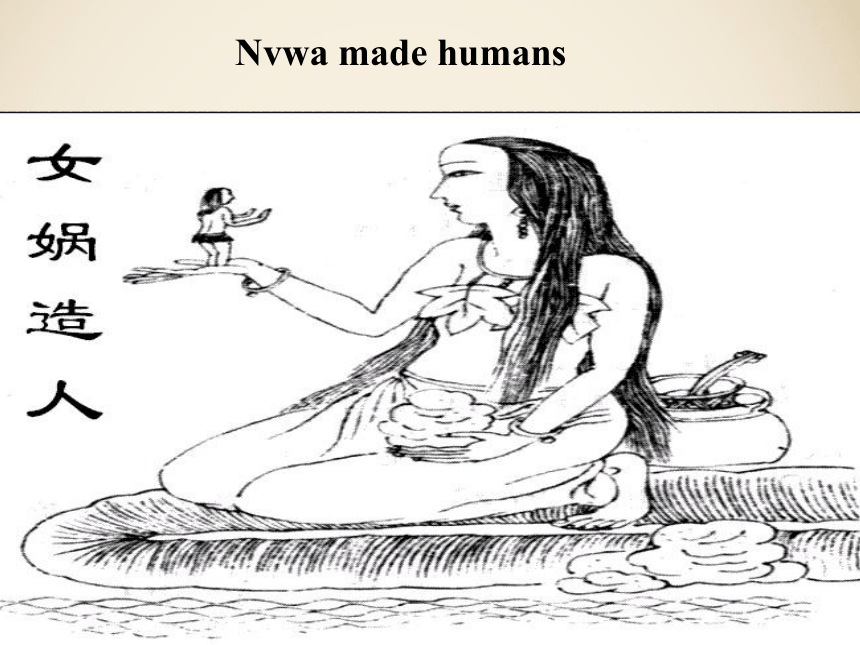
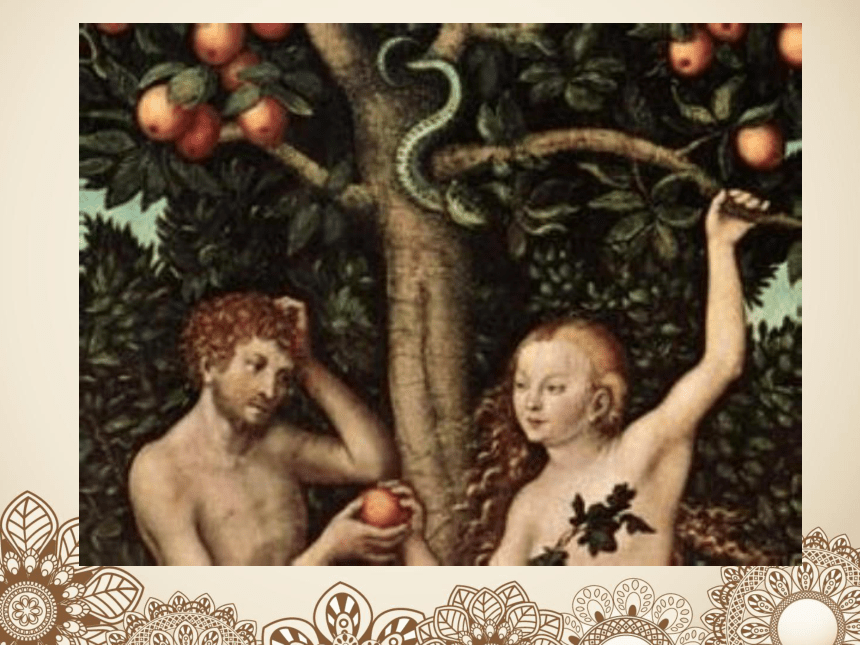
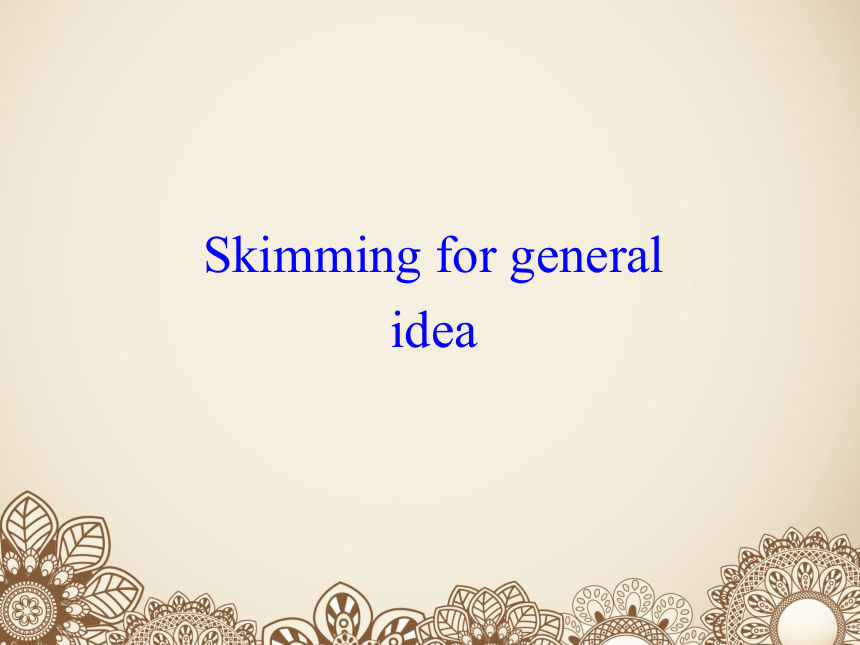
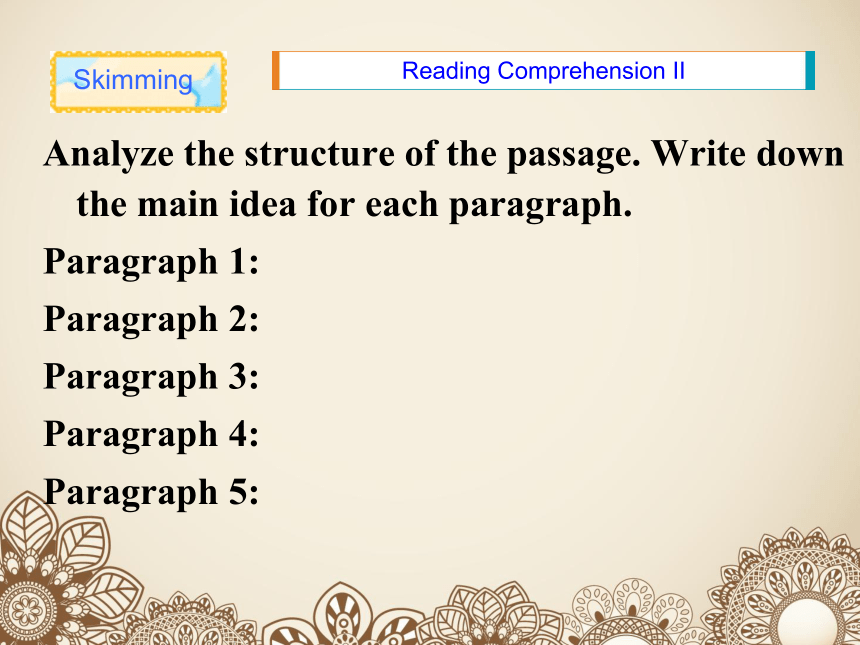
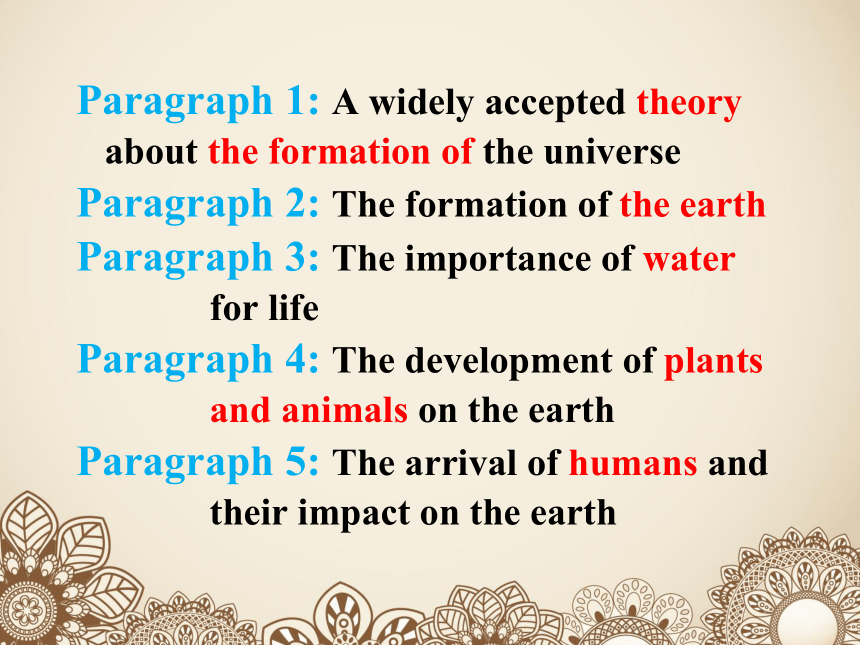
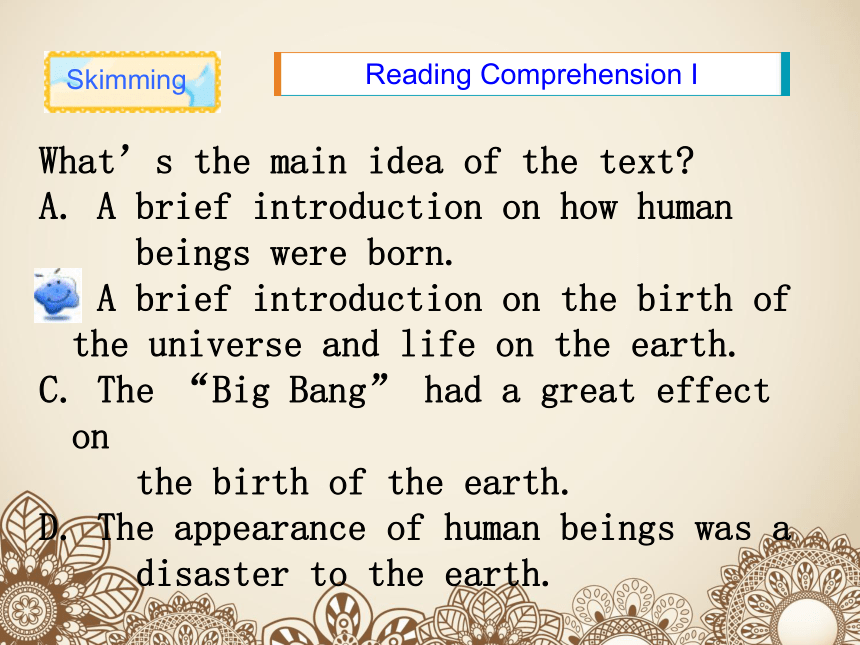
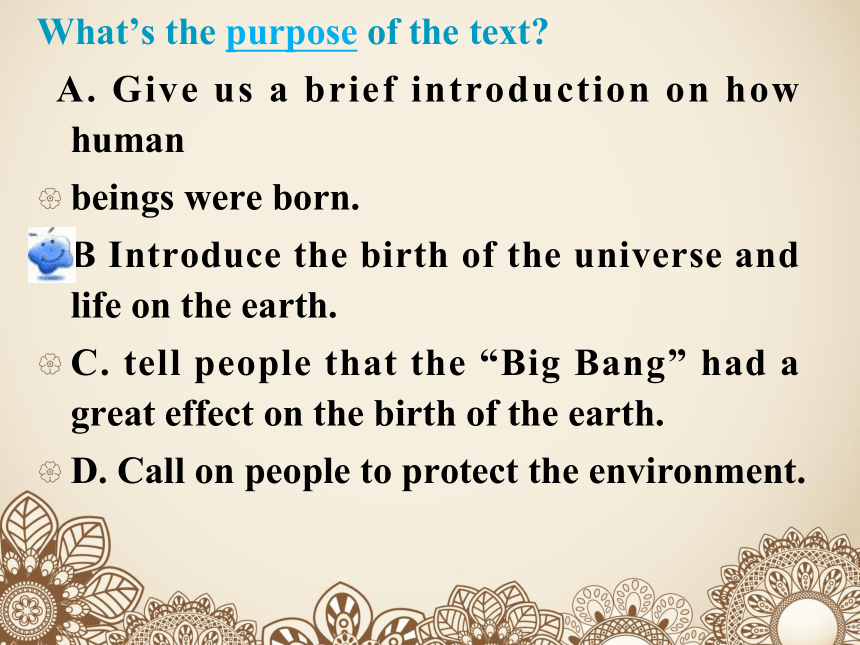
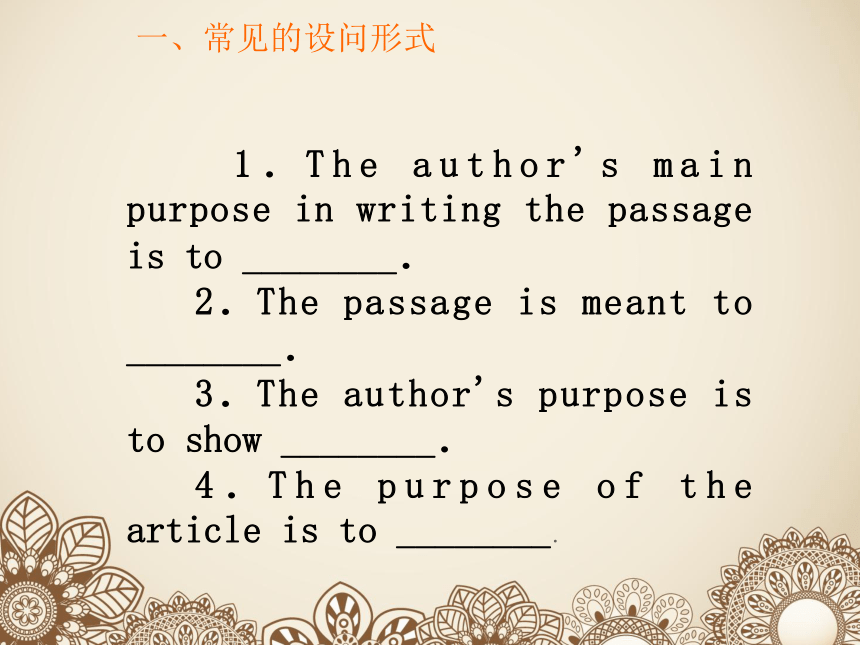
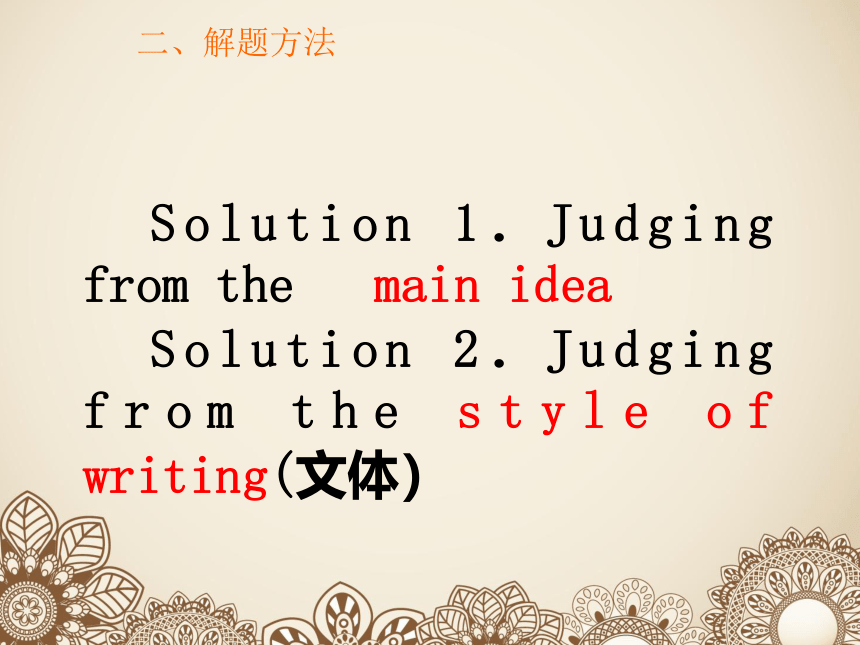
文档简介
(共30张PPT)
Module III Unit 4
Astronomy
1. To learn more knowledge about how life
began on the earth.
2. To learn how to do the inference question . (reading skill)
Objectives
Pangu separates the sky from the earth
Nvwa made humans
Skimming for general idea
Analyze the structure of the passage. Write down the main idea for each paragraph.
Paragraph 1:
Paragraph 2:
Paragraph 3:
Paragraph 4:
Paragraph 5:
Reading Comprehension II
Skimming
Paragraph 1: A widely accepted theory
about the formation of the universe
Paragraph 2: The formation of the earth
Paragraph 3: The importance of water
for life
Paragraph 4: The development of plants
and animals on the earth
Paragraph 5: The arrival of humans and
their impact on the earth
Reading Comprehension I
Skimming
What’s the main idea of the text?
A brief introduction on how human
beings were born.
B. A brief introduction on the birth of the universe and life on the earth.
C. The “Big Bang” had a great effect on
the birth of the earth.
D. The appearance of human beings was a
disaster to the earth.
What’s the purpose of the text?
A. Give us a brief introduction on how human
beings were born.
B Introduce the birth of the universe and life on the earth.
C. tell people that the “Big Bang” had a great effect on the birth of the earth.
D. Call on people to protect the environment.
1.The author's main purpose in writing the passage is to ________.
2.The passage is meant to ________.
3.The author's purpose is to show ________.
4.The purpose of the article is to ________.
一、常见的设问形式
Solution 1.Judging from the main idea
Solution 2.Judging from the style of writing(文体)
二、解题方法
Detailed Reading
The development of the earth
1. Big Bang (threw matter in all directions)
2. a cloud of dust
3. a solid globe
4. exploded with fire and rock
5. produce the carbon, nitrogen, water vapour, …
How did the earth come into being?
Stage 1: The development of the earth
6. cooled down
7. water appeared
8. harmful gases were dissolved
We can infer from the second paragraph that ________.
A. For several billion years after the “Big Bang”, the earth was still just a cloud of dust.
B. Carbon dioxide and water vapor formed the earth’s atmosphere.
C. The earth used to be a solid glob.
D. The earth revolves around the sun.
推断隐含意义的题干中常含infer(推断),suggest(暗示),imply(暗示),indicate(暗示),conclude(推断,得出结论)等词语。常见的题干设题形式如下:
1.We can know from the passage that ________.
2. We can infer from the (first/last) passage that ________.
3.The passage/author implies/suggests that ______.
4.It can be concluded from the passage that ________.
5.The underlined sentence indicates that ________.
一、常见的设问形式
二、解题方法
If the sentence is exactly taken from the text then it doesn’t belong to inference.
If the sentence is not complete then it is wrong
If the sentence is based on the common knowledge but irrelevant to the text, then it is wrong.
The development of life
in water
Stage 2 The development of life
on land
2
3
4
5
6
7
8
9
10
1 small plants in water
shellfish and all
sorts of fish
insects
reptiles
amphibians
mammals
dinosaurs
humans
plants
animals
Green plants on land
forests
Can you say sequence of development of life on the earth?
The word “ amphibians” probably refer to____.
A. fish live under the water
B. Animals live on land
C. Animals live on land as well as in the water
D. Plants live on land as well as in the water
Three steps to solve the detailed inference question:
Step 1:locate the key words.
Step2: read back to the sentence, which the keywords are in. Read three sentences at most.
Step 3: try to avoid over deduction.(推断)
二、解题方法
The author may probably agree with/support ________.
A. human beings are benefit lot from the earth.
B. millions of years later, the future of earth is unknown.
C. nature is still a mystery to us.
D. human beings were evolved(进化)from mermaid(美人鱼).
1.The author seems to be in favor of/against ______.
2.The author may probably agree with/support ________.
3.What's the author's opinion about...?
4.In the author's opinion...?
一、常见的设问形式
二、解题方法
You should find out the sentence that show the author’s opinion or judge form the “emotional” words.
Summary
What do we learn today?
如何做推断题
无中生有
与原文相矛盾
灭绝师太
常识错一定错
Homework
1.Find the difficulties in the passage.
2.Finish "Learning about Language" part on Page28.
End
Thank
you
Module III Unit 4
Astronomy
1. To learn more knowledge about how life
began on the earth.
2. To learn how to do the inference question . (reading skill)
Objectives
Pangu separates the sky from the earth
Nvwa made humans
Skimming for general idea
Analyze the structure of the passage. Write down the main idea for each paragraph.
Paragraph 1:
Paragraph 2:
Paragraph 3:
Paragraph 4:
Paragraph 5:
Reading Comprehension II
Skimming
Paragraph 1: A widely accepted theory
about the formation of the universe
Paragraph 2: The formation of the earth
Paragraph 3: The importance of water
for life
Paragraph 4: The development of plants
and animals on the earth
Paragraph 5: The arrival of humans and
their impact on the earth
Reading Comprehension I
Skimming
What’s the main idea of the text?
A brief introduction on how human
beings were born.
B. A brief introduction on the birth of the universe and life on the earth.
C. The “Big Bang” had a great effect on
the birth of the earth.
D. The appearance of human beings was a
disaster to the earth.
What’s the purpose of the text?
A. Give us a brief introduction on how human
beings were born.
B Introduce the birth of the universe and life on the earth.
C. tell people that the “Big Bang” had a great effect on the birth of the earth.
D. Call on people to protect the environment.
1.The author's main purpose in writing the passage is to ________.
2.The passage is meant to ________.
3.The author's purpose is to show ________.
4.The purpose of the article is to ________.
一、常见的设问形式
Solution 1.Judging from the main idea
Solution 2.Judging from the style of writing(文体)
二、解题方法
Detailed Reading
The development of the earth
1. Big Bang (threw matter in all directions)
2. a cloud of dust
3. a solid globe
4. exploded with fire and rock
5. produce the carbon, nitrogen, water vapour, …
How did the earth come into being?
Stage 1: The development of the earth
6. cooled down
7. water appeared
8. harmful gases were dissolved
We can infer from the second paragraph that ________.
A. For several billion years after the “Big Bang”, the earth was still just a cloud of dust.
B. Carbon dioxide and water vapor formed the earth’s atmosphere.
C. The earth used to be a solid glob.
D. The earth revolves around the sun.
推断隐含意义的题干中常含infer(推断),suggest(暗示),imply(暗示),indicate(暗示),conclude(推断,得出结论)等词语。常见的题干设题形式如下:
1.We can know from the passage that ________.
2. We can infer from the (first/last) passage that ________.
3.The passage/author implies/suggests that ______.
4.It can be concluded from the passage that ________.
5.The underlined sentence indicates that ________.
一、常见的设问形式
二、解题方法
If the sentence is exactly taken from the text then it doesn’t belong to inference.
If the sentence is not complete then it is wrong
If the sentence is based on the common knowledge but irrelevant to the text, then it is wrong.
The development of life
in water
Stage 2 The development of life
on land
2
3
4
5
6
7
8
9
10
1 small plants in water
shellfish and all
sorts of fish
insects
reptiles
amphibians
mammals
dinosaurs
humans
plants
animals
Green plants on land
forests
Can you say sequence of development of life on the earth?
The word “ amphibians” probably refer to____.
A. fish live under the water
B. Animals live on land
C. Animals live on land as well as in the water
D. Plants live on land as well as in the water
Three steps to solve the detailed inference question:
Step 1:locate the key words.
Step2: read back to the sentence, which the keywords are in. Read three sentences at most.
Step 3: try to avoid over deduction.(推断)
二、解题方法
The author may probably agree with/support ________.
A. human beings are benefit lot from the earth.
B. millions of years later, the future of earth is unknown.
C. nature is still a mystery to us.
D. human beings were evolved(进化)from mermaid(美人鱼).
1.The author seems to be in favor of/against ______.
2.The author may probably agree with/support ________.
3.What's the author's opinion about...?
4.In the author's opinion...?
一、常见的设问形式
二、解题方法
You should find out the sentence that show the author’s opinion or judge form the “emotional” words.
Summary
What do we learn today?
如何做推断题
无中生有
与原文相矛盾
灭绝师太
常识错一定错
Homework
1.Find the difficulties in the passage.
2.Finish "Learning about Language" part on Page28.
End
Thank
you
同课章节目录
